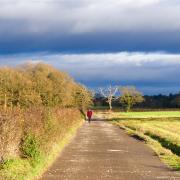Standing on an English beach, looking out across the blue-grey waves towards the horizon, what do you see? A vast expanse of empty water: cold, dark, unknown? Look a little closer and you’ll find UK seas are as diverse as coral reefs and home to a mind-boggling variety of weird and wonderful creatures.
In Cheshire, we have two of the richest marine environments in the region: the Dee and Mersey estuaries. There are many different marine habitats and all play a vital role in the health of our seas and our land. We have some of the most amazing ones here in Cheshire including mudflats, saltmarsh, reedbed and sand dunes.
Here are some of the creatures to look out for when you're standing on the shoreline.
Because estuaries empty during low tide the exposed coastal habitat of the mudflats are home to some pretty tough critters, such as the common cockle.

Common name: Common Cockle
Scientific name: Cerastoderma edule
Type of animal: Bivalve mollusc
Diet: Filters plankton and other organic matter from the water.
Estimated life span: 5 to 10 years
Size: Up to 5cm long (about the size of a golf ball).
Distinguishing features: This is the most common cockle found on our shores and the one most likely to be found washed up on the beach. The outer surface of the shell is off-white, yellowish, or brown, and the inside is white.
Did you know: Cockles can reach densities of up to 10,000 individuals per square metre? In winter, common cockles don't grow very much, which leads to the marked growth-bands on the shell; these bands can be used to age cockles.
Conservation status: Common
Distribution: Found all around UK coasts.
At high tide explore the sand dunes where you could see one of the UK’s most well camouflaged species between June and September.
Common name: Grayling Butterfly
Scientific name: Hipparchia semele
Type of animal: Butterfly
Diet: The caterpillars feed on a variety of grasses including sheep's fescue, red fescue and marram grass. The butterflies feed on nectar from sea holly (a type of thistle).
Estimated life span: A few weeks
Size: Wingspan: 5.1-6.2cm
Distinguishing features: The grayling is mainly dark brown above, with washed-out orange markings. The underside of the forewing is orange and the hindwing has an intricate grey-and-black pattern. The best way to identify the 'brown' butterflies is by looking at the eyespots on their wings. The combination of orange and brown markings, together with two large eyespots on the underside of the forewing and one smaller eyespot on the hindwing, is unique to the grayling.
Did you know: There are six subspecies of grayling butterfly occurring in the UK, including one found on the Great Orme in North Wales where they are smaller than normal.
Conservation status: Highly threatened with extinction in many parts of its range.
Distribution: Coastal habitats and on inland heathlands.
Here is another cryptic, and highly threatened, species that call the sand dunes home.

Common name: Natterjack Toad
Scientific name: Epidalea calamita
Type of animal: Amphibian
Diet: Insects such as moths and woodlice.
Estimated life span: Up to 15 years.
Size: Length: 6-8cm
Weight: 4-19g
Distinguishing features: The natterjack toad is more olive-green in colour than the common toad and has a distinguishing yellow stripe running down its back. It tends to run instead of walking or hopping, giving it the name the 'running toad'.
Did you know: Natterjack toads lay their spawn in 1-2m strings in temporary, shallow ponds, warmed by the sun. One clutch can contain up to 7,500 eggs. It takes just six to eight weeks for young natterjack toadlets to develop from the spawn.
Conservation status: Highly threatened in much of its range. Some reintroduced populations increasing.
Distribution: A rare toad, only found at a handful of sites in southeast England, northwest England, East Anglia, North Wales and parts of Scotland.
Please don’t go out looking for natterjack toads as they are protected under licence. If you want to learn more about them contact your local Wildlife Trust as they often host guided walks in natterjack toad habitat.
Looking to the skies at this time of year around the Dee Estuary you may see a Southern Hemisphere visitor here for the breeding season.
Common name: Common Tern
Scientific name: Sterna hirundo
Type of animal: Seabird
Diet: Small fish
Estimated life span: 12 years
Size: Length: 31-35cm
Wingspan: 77-98cm
Weight: 90-150g
Distinguishing features: The common tern is white below, has tail streamers, and has a long bill, which is orangey-red with a black tip. It is silvery-grey above, with a black cap and short, red legs.
Did you know: The common tern's long tail streamers (feathers extending past the main tail) have earned it the nickname sea-swallow.
Conservation status: Classified in the UK as Amber under the Birds of Conservation Concern 5: the Red List for Birds (2021).
Distribution: Welsh side of the Dee Estuary from April to September.

Common name: Little Tern
Scientific name: Sternula albifrons
Type of animal: Seabird
Diet: Small fish
Estimated life span: 12 years
Size: Length: 22-24cm
Wingspan: 48-55cm
Weight: 49-63g
Distinguishing features: Living up to its name, the little tern is the UK's smallest tern. Silvery-grey above and white below, the little tern has a black cap, a black eye stripe, and a white forehead. It has a short tail, tiny, yellowy-orange legs, and yellow bill with a black tip.
Did you know: During their courtship, male little terns put on impressive aerial displays that involve carrying fish to attract mates. The females will chase them high up into the sky; the males then descending at a glide with their wings forming a V shape.
Conservation status: Classified in the UK as Amber under the Birds of Conservation Concern 5: the Red List for Birds (2021).
Distribution: Welsh side of the Dee Estuary from April to September.
However, it can get a bit confusing as the Dee Estuary is a nesting site for another tern species.

Summer is a great time to get out and explore the estuaries in Cheshire with plenty of places to walk and take in the views across the water.
The Our Dee Estuary project, a cross-border partnership project hosted by Cheshire Wildlife Trust is working to restore and protect some of these habitats and the species they support. Find out more: cheshirewildlifetrust.org.uk/ourdeeestuary



























